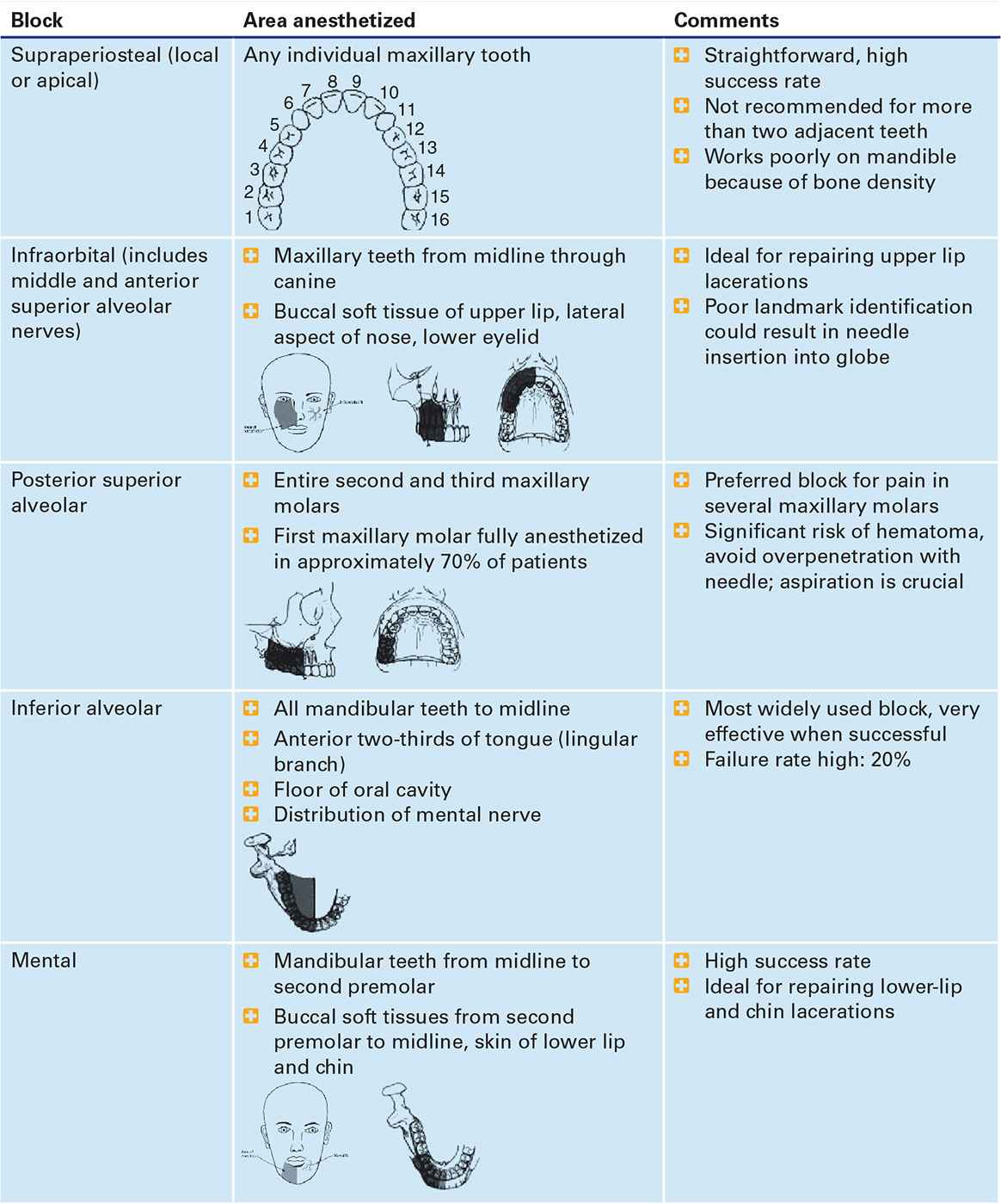![]() To provide temporary analgesia for intraoral or facial pain related to the following:
To provide temporary analgesia for intraoral or facial pain related to the following:
![]() Trauma requiring intraoral or facial laceration repair
Trauma requiring intraoral or facial laceration repair
![]() Dental trauma resulting in fractured teeth
Dental trauma resulting in fractured teeth
![]() Infection (tooth abscess, root impaction, gum disease) (TABLE 79.1)
Infection (tooth abscess, root impaction, gum disease) (TABLE 79.1)
CONTRAINDICATIONS
![]() Absolute Contraindications
Absolute Contraindications
![]() Hypersensitivity/allergic reaction to local anesthetic agents
Hypersensitivity/allergic reaction to local anesthetic agents
![]() Relative Contraindications
Relative Contraindications
![]() Coagulopathy
Coagulopathy
![]() Uncooperative or obtunded patients
Uncooperative or obtunded patients
LANDMARKS AND TECHNIQUE
![]() Equipment and Patient Positioning
Equipment and Patient Positioning
![]() Adjust examination chair to accommodate patient height
Adjust examination chair to accommodate patient height
![]() Ensure adequate lighting to visualize oral landmarks
Ensure adequate lighting to visualize oral landmarks
![]() Assemble the necessary tools
Assemble the necessary tools
![]() Sterile “thumb-control” Monoject aspirating dental syringe
Sterile “thumb-control” Monoject aspirating dental syringe
![]() 1½-inch 25- to 27-gauge needle
1½-inch 25- to 27-gauge needle
![]() Carpule cartridges containing anesthetic (either 2% lidocaine or 0.5% bupivacaine each with epinephrine 1:100,000 and 1:200,000 respectively)
Carpule cartridges containing anesthetic (either 2% lidocaine or 0.5% bupivacaine each with epinephrine 1:100,000 and 1:200,000 respectively)
![]() Cotton-tipped applicators for administering topical anesthetic and controlling bleeding
Cotton-tipped applicators for administering topical anesthetic and controlling bleeding
![]() Apply topical anesthetic (20% benzocaine or 5% to 10% lidocaine ointment) to mucosa before injection
Apply topical anesthetic (20% benzocaine or 5% to 10% lidocaine ointment) to mucosa before injection
![]() Use lidocaine for laceration repairs and bupivacaine for dental blocks; 0.5% bupivacaine provides roughly 1 to 3 hours of dental pulp analgesia and 4 to 9 hours of soft-tissue analgesia
Use lidocaine for laceration repairs and bupivacaine for dental blocks; 0.5% bupivacaine provides roughly 1 to 3 hours of dental pulp analgesia and 4 to 9 hours of soft-tissue analgesia
![]() Buffering with bicarbonate is not recommended
Buffering with bicarbonate is not recommended
SUPRAPERIOSTEAL NERVE BLOCK
![]() Apply topical anesthetic to apex of mucobuccal fold adjacent to the affected tooth
Apply topical anesthetic to apex of mucobuccal fold adjacent to the affected tooth
![]() Lift the patient’s upper lip and pull the tissue taut
Lift the patient’s upper lip and pull the tissue taut
![]() Orient needle and syringe parallel to the long axis of the tooth
Orient needle and syringe parallel to the long axis of the tooth
![]() Insert needle into the target area with the bevel facing the bone
Insert needle into the target area with the bevel facing the bone
![]() Advance and aspirate until the needle is a few millimeters beyond the apex of the tooth
Advance and aspirate until the needle is a few millimeters beyond the apex of the tooth
![]() If aspiration is negative then inject approximately 2 mL of anesthetic (FIGURE 79.1)
If aspiration is negative then inject approximately 2 mL of anesthetic (FIGURE 79.1)
INFRAORBITAL NERVE BLOCK
See Chapter 80 (Facial Nerve Blocks)
POSTERIOR SUPERIOR ALVEOLAR NERVE BLOCK
![]() Apply topical anesthetic to apex of mucobuccal fold above the second maxillary molar
Apply topical anesthetic to apex of mucobuccal fold above the second maxillary molar
![]() Have the patient partially open the mouth and deviate the mandible toward the side of the pain to create more room
Have the patient partially open the mouth and deviate the mandible toward the side of the pain to create more room
![]() Use your index finger to retract the patient’s cheek on the side being injected and pull the tissue taut
Use your index finger to retract the patient’s cheek on the side being injected and pull the tissue taut
TYPES OF DENTAL BLOCKS |

Stay updated, free articles. Join our Telegram channel

Full access? Get Clinical Tree


